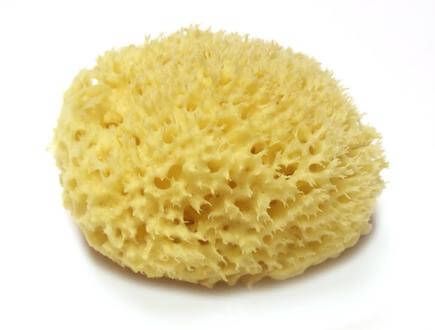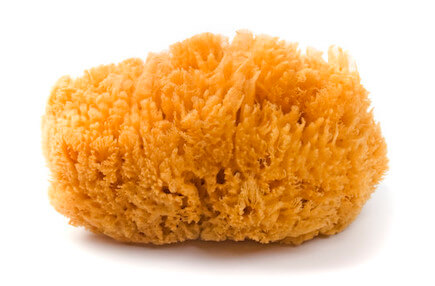What are the different types of natural sponges ?
There are several types of natural sponges :
- Natural sea sponges: There are all kinds of sea sponges and only 15% of all that grow at sea are harvested for sale. The diversity of sponges is vast, they differ in terms of their shape, color and size.
- Konjac sponges : is a root of the Amorphophalus Konjac plant, used for centuries in Japan. Known for its medical benefits, the root is also used to make a vegetable sponge with exceptional cleansing and exfoliating properties.
- Loofah sponges : a vegetable sponge that you can grow yourself! It comes from the Luffa squash, which looks like a zucchini or cucumber. Once dried, its fibrous tissue makes it possible to make exfoliating vegetable sponges. They can be easily used in the kitchen or in the bathroom.
- Sponges made from viscose (wood paste and soda) and linen : a natural sponge 100% biodegradable and eco-designed, it will be used in the kitchen as well as in the bathroom.
The sea sponge, the natural sponge for the body par excellence
What is a sea sponge?

Natural sea sponges, also called sponges or Porifera, are marine organisms, classified as multicellular. Without brains or nervous system, these marine animals live on a stable support like a rock or pebbles and have been growing in the sea for centuries.
Sea sponges have an excellent and constant ability to renew themselves. You can take some of them and they will grow back quickly, without being damaged. They are therefore a natural, renewable and biodegradable source. Sponges are therefore an excellent ecological alternative to replace all kinds of synthetic sponges.
The natural sponges marketed are only the skeleton of the sponge. These natural sponges have been fished and marketed for centuries, especially in the Greek Islands. At the time, fishing for natural sea sponges was done only with bare hands. In recent decades, sea sponge fishing has become a profession, so it is a professional diver, equipped with a gas cylinder, who fetch the sponges from the depths of the cold sea waters.
The Mediterranean is the preferred sea for sponges. Today it is in Greece where the harvest of these natural sea sponges takes precedence.
To learn more and find out more about what a sea sponge is for you can find our article here.
What are the benefits of cleaning with a sea sponge?

A sea sponge is the most natural and healthy way to cleanse and take care of your skin and body! No wonder it has been used in skin care for over 2,000 years. Even today, the natural sea sponge is perfect to accompany us in the shower or in the bath.
Sea sponges have everything to seduce in terms of care. Natural, environmentally friendly and perfectly suited to all skin types, even the most demanding ones.
Sea sponges ave many benefits : they are very absorbent, create a smooth, pleasant lather, are slightly textured and are suitable for the most sensitive skin. This natural sponge is more durable than a synthetic sponge because it is more abrasion resistant - with good hygiene it can last up to 8 years!
When a sea sponge is dry, it is rough and stiff. Its structure resembles a large honeycomb, making it perfect to make the skin clean and smooth. The natural sea sponge will gently exfoliate the epidermis and stimulate microcirculation. The regular use of a sea sponge is incomparable in terms of care and gives the skin a beautiful color, a beautiful radiance and delays aging.
The minerals contained nourish the skin with many elements that it needs. Boosting the foaming effect of a solid beauty product, natural sponges gently exfoliate impurities and dead cells to cleanse the face and reduce fine lines. A natural sea sponge leaves the skin extremely smooth, free from blemishes and silky.
A sea sponge is the most natural and healthy way to clean and take care of yourself in your bath! No wonder it has been used in skin care for over 2,000 years. Even today, the natural sponge is perfect to accompany us in the shower or in the bath.
Sea sponges are hypoallergenic because they do not contain chemicals, artificial colors, or toxins. Plus, they're better for bathing and cleaning because they absorb and hold more water without losing any. The sea sponge is self-cleaning thanks to its complex system of channels. Therefore, it rinses off faster and easier, so that it does not absorb unpleasant odors. It is softer and cleaner than its synthetic counterpart. Sea sponge is a safe alternative to baby washing, outperforming artificial substitutes in terms of quality. Limiting the multiplication of bacteria and molds, it has a seboregulatory effect, preserving the acidic pH of the skin and its health. You only need to try it once, and you will never be without your natural sea sponge again.
How to use a sea sponge?
Before using the sea sponge for washing, moisten it thoroughly, which will cause it to swell. It can be used in combination with your favorite cosmetic products, but we recommend that you also use it without additional products, so that the skin can only absorb valuable marine elements. The natural sponge does not cause allergies and irritation because it is a pure raw material that takes care of the qualities of the skin. When your shower or bath is finished, rinse it off properly with lukewarm water to remove any soap residue. Air dry there completely.
How to maintain a sea sponge?
To fully benefit from all the advantages of the sea sponge, it is necessary to follow some maintaining principles that you will find it in detail here. Before using your natural sea sponge for the first time, clean it with water and a little soap. Be careful not to put hot water on the sponge, this alters its structure and decreases its longevity. Like a solid cosmetic, a sea sponge should air dry. Avoid laying it down, as the laid part will not dry properly. Hang there so that it can dry completely.
To extend its durability, once a week, soak the sponge in 1 cup of lukewarm water mixed with 1 tablespoon of baking soda for 15 minutes. Then rinse and let dry. The baking soda will clean the sponge and revitalize its cellular structure, increasing its durability. Let your sponge dry completely after each use. Don't keep it in the shower, hang it somewhere to let it dry completely.